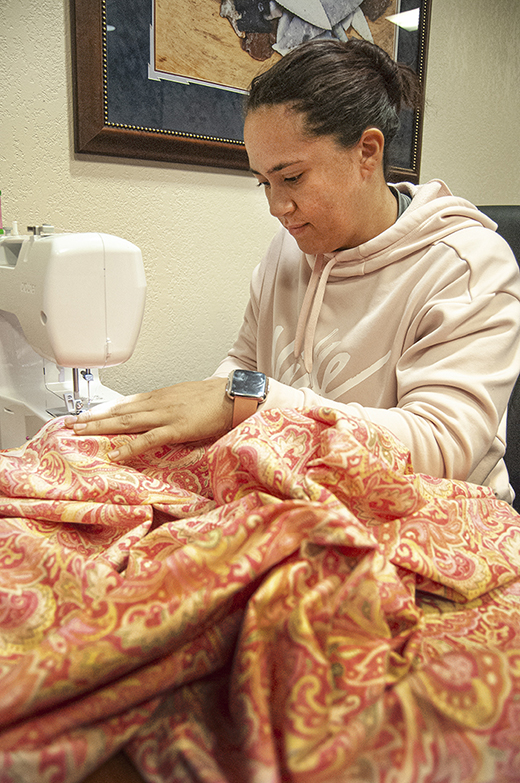Chickasaw regalia designers turn talents to making masks

This article appeared in the May 2020 edition of the Chickasaw Times
ADA, Okla. – Regalia Making Mothers, a group formed by Chickasaws to provide First American regalia for American Indian foster children, is now making face masks to protect the health of tribal elders.
The group began as a way to provide regalia for children before the COVID-19 pandemic hit the nation. Skirts, vests, ribbon shirts and other fashion items were being prepared for dances and other ceremonies. Those events are now canceled or indefinitely postponed.
As the pandemic has gripped the nation, the need for masks became paramount to protect elders. Elders are at greater risk of succumbing to the virus due to underlying medical conditions such as heart disease and diabetes.
Regalia Making Mothers began when Chickasaws were asked if they would be interested in making regalia to help introduce young people to their Indian culture. The idea took off like an Oklahoma prairie fire. The idea to bring together the talents of Chickasaws came to Chickasaw Nation Medical Center nurse Sonya Frazer late last year. Regalia Making Mothers total 25 members. Prior to the pandemic, the group met every other week in the Chickasaw Community Center conference room in Ada. The group turned the meeting room into a sewing and cutting room where child-sized ribbon skirts, ribbon shirts, dresses, vests and other garments indicative of Chickasaw and American Indian heritage were crafted. However, as the pandemic swept America, the group turned to making face masks.
National health experts initially said facial masks were not necessary, but experts did an about face in late March and began recommending them for the general public.
Filters are sewn into the masks. The filters trap small particles that might sicken elders. American Indian patterns bring beauty and solace curing this stressful and uncertain time. The team is making masks daily for tribal elders since no one is certain when the COVID-19 risk will pass.
In the past, Regalia Making Mothers gathered as a group, shared ideas, assisted one another with projects and inspired one another’s creative notions. They last came together Feb. 26, shared a meal, prayer and enjoyed social interaction.
When the first cases of COVID-19 were confirmed in Washington state, gathering as a team ended with the pandemic and members now work from home.
The group is inventive, often incorporating fabric not necessarily resembling traditional American Indian patterns.
Raymond Cooper, a Choctaw citizen, completed a ribbon skirt with beautifully coordinated ribbons sewn to fabric covered with images of Walt Disney’s Minnie Mouse.
“To a young female American Indian, this will bring joy to her heart,” Mr. Cooper said.
Within an hour, he had finished a ribbon vest for an American Indian male foster child with a Mickey Mouse theme.
Mr. Cooper did not use a pattern to make the items. He has been cutting and sewing since childhood. Isolated at home after being diagnosed with tuberculosis, his mother taught him as a child how to sew, cut fabric and craft garments through intuition and educated guesses. He also is a master at beading and has been called on by others in the group to place beaded bling into a few of the garments.
Chickasaw Jennifer Kellner, a Chickasaw Nation Family Services employee, was particularly thrilled to be working on garments featuring a multi-colored paisley pattern. Stationed at a sewing machine, Ms. Kellner worked from a pattern. It would result in a traditional tribal prairie skirt after it was cut, hemmed, fashioned with ribbons and elastic tucked into the waist.
“There is just an excess of color in this. I love it,” she said while wrestling with the large bundle of material. “So many items can come from this fabric, it’s just a matter of deciding on what to make.” Cassandra Alexander, a Chickasaw Nation outreach supervisor with Community Services, was finishing a Navy blue skirt adorned with orange, yellow, pink and lime green ribbons.
“I think this project is wonderful,” she said. “It gives American Indian children in foster care the identity they need to honor their heritage. It is important and I am so pleased to be a part of it.” Alicia joy Gibson and her eight year-old daughter, Lilah, worked in tandem. Ms. Gibson is employed by the Chickasaw Nation’s Department of Health and is quite handy with a sewing machine.
Lilah helped her mother craft a small blue floral skirt with white, red and blue ribbons. An elastic waistband put the finishing touch on the piece, and Lilah took a moment to pose for a picture with it. “It’s pretty,” the shy youngster said in a quiet voice.
Fabric with butterflies was quite popular at the Feb. 26 gathering. Jennifer Jesse and her 11-year-old daughter, Jacobe, were attempting to color-match a band of light bluish-green fabric laden with butterfly prints to complement a taupe skirt. A debate ensued between mother and daughter if perhaps other colors would coordinate better. On this night, the issue was unresolved, and the garment would wait for another opportunity to spring to life. Jesse works for the Chickasaw Nation in public health. Her daughter is a student at Byng High School.
Chickasaw citizen Sonya Frazier did not have the same issue when preparing a butterfly band on kelly green fabric. The beautiful butterfly bolt – red, blue, green, purple – worked perfectly. What she struggled with was the color combination of ribbons she planned to use to finish the project.
Sprawled on the floor in front of two pieces of cloth, she placed spools of ribbon on either side of the butterfly band to determine which would be the most flattering. Sewing team members Beth Harvey and Rita Hart made a few suggestions.
She looked up and smiled after hearing the varying options.